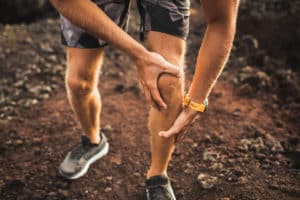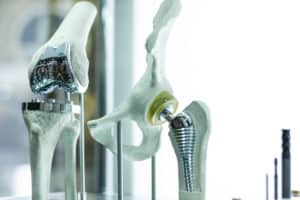Knee Injury
Home » Personal Injury Resources » Types of Injuries » Knee Injuries

Your knees provide the necessary flexibility to perform many of the actions you may take for granted. Standing, walking, and carrying can become impossible if you have bad knees.
Your knees bring together several bones, muscles, tendons, and ligaments. If anything goes wrong in your knees, you may face a long recovery time or even a permanent knee disability.
Read on to learn about the causes and effects of a knee injury and how you can seek compensation for one.
Table of Contents
The Complexity of the Knee: What is its Structure?

Your knee might seem like a simple joint between your thigh and calf. But your knee is one of the most complicated joints in your body. It brings together three bones, five ligaments, and two of the largest muscle groups in your body. Cartilage lines the knee joint to cushion the bones and provide a smooth surface for them to move.
The thigh bone, called the femur, has articular cartilage lining the end that meets the knee. One calf bone, called the tibia, sits directly below the femur. Cartilage discs, called the meniscus, rest between the interface of the femur and tibia.
The other calf bone, called the fibula, sits behind the tibia. The fibula does not bear any of your weight. Instead, it stabilizes the tibia and provides flexibility to the ankle.
The patella sits over the knee. Also referred to as the kneecap, the patella protects the knee from impacts.
The bones provide stability to your leg. They also provide leverage to the leg muscles so they can move your legs. The leg muscles attach to the bones through tendons.
Ligaments connect the femur and tibia. Anyone who follows sports has probably heard of at least some of the knee ligaments because athletes can stretch or tear these ligaments, leading to a knee injury. The five major ligaments in the knee are as follows:
Patellar Ligament
The patellar ligament is sometimes mistakenly called the patellar tendon. But this ligament connects the patella to the tibia. Above the patella, the quadriceps tendon attaches the quadriceps muscle to the patella.
Medial Collateral Ligament (MCL)
The MCL connects the femur to the tibia on the inner side of your knee. It provides lateral stability to your knee by preventing the femur and tibia from sliding sideways against each other when you step to the side.
Lateral Collateral Ligament (LCL)
The LCL connects the femur to the fibula on the outer side of your knee. Like the MCL, it provides lateral stability to your knee. It also provides lateral flexibility so you can push off as you step to the side without causing the femur and fibula to slide against each other.
Anterior Cruciate Ligament (ACL)
The ACL sits inside your knee and connects the femur to the tibia. The ACL sits toward the front of your knee and prevents the femur from sliding backward on the tibia as you bend your knee.
Posterior Cruciate Ligament (PCL)
Your PCL also sits inside your knee. It connects the femur to the tibia near the rear of your knee. It prevents the femur from sliding forward on the tibia as you bend your knee. The ACL and PCL also provide the flexibility and stability to push forward or backward as you walk.
How Do Knee Injuries Happen?
Traumatic knee injuries can happen in several ways. But in an accident, you will likely suffer one of three types of knee injuries:
Penetrating Knee Injury
When an object pierces your knee, you suffer a penetrating knee injury. A penetrating knee injury can sever the ligaments, tendons, and muscles in your knee. It can also slice or tear the cartilage in your knee.
Blunt Force Knee Injury
A blunt force knee injury happens when something impacts your knee or vice versa. If your knee hits the ground in a trip and fall accident, you can suffer a blunt force knee injury. Similarly, if a car hits your knee in a pedestrian accident, the car could cause a blunt force knee injury.
Blunt force knee injuries can fracture the femur, tibia, patella, or fibula. They can also hyperextend the ligaments, tendons, and muscles in your knee.
Hyperextension Injury
A hyperextension injury happens when your knee gets bent or stretched beyond its capacity. In a car accident, your leg can get pinned under the dashboard. As the force of the accident causes your leg to bend, you can hyperextend your knee.
What Are Some Examples of Knee Injuries?
Your knee tissue can get injured in many ways, including:
Strained Knee
A strain happens when the tendons or muscles in your knee get stretched or torn.
Symptoms of a knee strain include:
- Pain
- Swelling
- Weakness
- Limited range of motion
- Muscle spasms
A strained knee will usually heal in four to six weeks with rest. Doctors may recommend icing the injury and taking anti-inflammatory medications to keep the swelling down and relieve any pain.
Sprained Knee
A knee sprain happens when the ligaments in the knee stretch or tear.
A knee sprain can produce symptoms like:
- Pain
- Swelling
- Knee instability
- Knee stiffness
- Bruises
- Popping sound or sensation during your accident
A stretched ligament will probably heal on its own with rest, ice, and anti-inflammatory drugs. A torn knee ligament may require surgical repair.
Torn Cartilage
Cartilage is a smooth but tough material formed from collagen proteins. When it tears, pieces of cartilage can get trapped in your knee, impeding its function.
Symptoms of torn knee cartilage include:
- Pain
- Swelling
- Clicking in the knee
- Hitching or grinding in the knee as you move it
Cartilage tears that occur without any debris in the knee can heal without surgery. You may need a brace to stabilize the knee while it heals, and physical therapy can help strengthen the muscles around the knee to better support it.
If the knee contains pieces of torn cartilage floating inside the joint, doctors may recommend surgery to clean out the knee.
How Do You Seek Compensation for a Knee Injury?
You may be entitled to seek injury compensation from anyone who caused your injury through negligent or intentional actions. Thus, if you injured your knee in a car crash, you will need to show that another driver caused the crash. When you do so, you can seek compensation for your medical bills, lost wages, and pain and suffering. To learn more about pursuing a personal injury claim for your knee injury, contact M&Y Personal Injury Lawyers for a free consultation.
